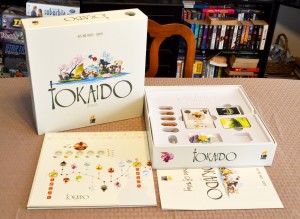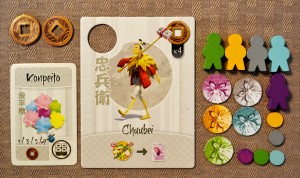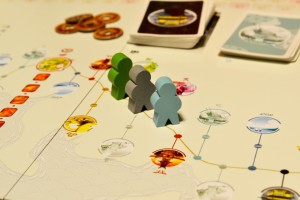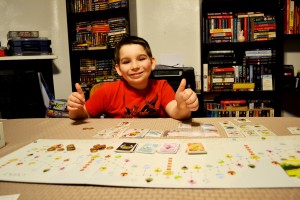Konnichiwa, fellow travelers! We’re here today to take a quick look at “Tokaido”, a game I recently picked up on a whim. It looked pretty enough based on the pictures I browsed and promised to be family-friendly to boot. The premise is simple enough: each player takes on the role of a traveler who is making their way across the “East Sea Road”, a famous and popular road (of the “Edo” period) located in Japan. Players will be able to visit a variety of different places with the intent on earning the most victory points by the game’s end. The kicker is that there’s no going backwards…think “Candy Land” but with a Japanese theme and juiced up on steroids. After spending some time with the game, I discovered that it delivers all of the above and more.
Components
Game Board – The game board is fairly large in terms of length, featuring the path or road in which players will travel, a score track on one side with a “temple” nearby, and various spaces reserved for decks of cards.
Traveler Pieces, Point Markers, and Color Tokens – There are a total of five traveler pieces (meeples), which are used to represent the player as they move along the game board’s path. There are also five point markers (one of each color like the traveler pieces), which are used on the score track. Finally, there are five color tokens (one of each color), which players will place inside their traveler tiles to show what color they represent.
Traveler Tiles – Each of these ten tiles lists a unique character with some sort of special ability. Each player will assume the role of one at the beginning of the game.
Coins – This is the currency that players will be using throughout the game.
Cards – There are hot spring cards, panorama cards, meal cards, souvenir cards, encounter cards, and achievement cards. They each act differently, but suffice it to say that they contribute to a player’s success (via coin or victory points) in some way.
Setup & Gameplay
The meal, souvenir, encounter, and hot spring cards are shuffled separately and placed in their own face-down spot on the board. The same happens with the panorama cards in that they are separated by type, though they are placed in numeric order (one’s on top and three’s/four’s/five’s on the bottom). The achievement cards are placed face up next to the board. Each player picks two traveler tiles at random, chooses one, and places it face up in front of them. Each player also gets a traveler piece and the corresponding token & point marker. The token goes inside the individual player’s traveler tile while the point marker goes on the “0” space of the point track. Players also get starting coin, equal to the value listed on their traveler tile. Finally, the traveler pieces are randomly placed in a line at the first inn (Kyoto).
There’s a lot here with regard to how the board and different cards work, so I’ll opt to instead hi-lite the relevent points to help keep the review at a respectable length. The board is made up of one, long single path. On this path are differently colored spaces which match the card backs of the various decks on the board. Landing on these spaces usually involves drawing a card of the corresponding color, collecting coins, or interacting with the board in some way. On their turn, players can move their traveler piece forward as many spaces as they want up to the next inn space. The player who is furthest behind on the path always moves next. Players also cannot occupy the same space, except for the inn and special spaces marked in a four/five player game.
The idea here is for players to earn as many points as they can while traveling to Edo, the last space, in order to win the game. To do that, they’ll attempt to land on the colored spaces that would best benefit them at the time. They all do something different, with some awarding points in different ways, so you’ll need to think before you move. The temple space, for example, allows the player to donate coins for a return of one victory point per coin. At the end of the game, bonus points are awarded to players based on how much they contributed. Panorama cards, on the other hand, only reward victory points straight away. The number of victory points rewarded in this fashion however escalates as players acquire more panorama cards of the same type. Hot spring cards are a bit simpler in that they are a one-time victory point boost with no strings attached.
As you can see, there’s a lot to cover when it comes to the cards and various spaces on the board. The game ends when all players make it to the final inn space, signaling the end of their journey. Acheivement cards and temple bonuses are then awarded, as appropriate. The player with the most victory points at that point, wins!
Editor’s Note: The above doesn’t cover all of the rules found in the manual, but should give you a good idea as to how the game is played. For more information, you can check out the manual here:
http://www.funforge.fr/US/files/tokaido/Tokaido_rules_US_LD.pdf
The Review
The visuals attracted me immediately and were part of the reason why I picked up the game in the first place. “Takenoko” had a similar effect on me…of course, feeding bamboo to the panda for victory points had a unique appeal as well. The quality of the components weren’t bad either and I felt that everything functioned the way they were supposed to, though the coins were a pain to punch out. The box insert is “okay”, but I would have prefered a few baggies and a one large groove as opposed to smaller, individual grooves. The board is a bit on the long side, so make sure you have a dining room table handy as opposed to say, a card table. The rules are both easy and difficult to understand, in my opinion. They are difficult in the sense that there are so many gameplay mechanics to consider when looking at all of the available spaces in the game. On the other hand, each card type or space is fairly easy to resolve. It takes more time to figure out how to use them to your advantage than it does to resolve what they actually do, if that makes sense.
Part of me felt guilty for not listing out all of the card types and their effects, for this is really where the game reaches its peak in terms of strategic replayability. There’s just so many different ways for players to earn points! The challenge is taking into account the special ability you might have at the time, as well as what achievement cards you’re aiming to collect. Achievement cards, for those who are curious, are bonuses players earn for satisfying a particular objective. Some are awarded immediately (for completing panorama sets) and some are awarded at the game’s end (having the most hot spring cards, etc.). Chokepoints are present in the form of inns, forcing all players to wait for everyone else to catch up. Those who arrive first at an inn though get their choice of meal cards (which also earn players victory points). There I go again, rambling on and on about the cards, but it’s difficult not to.
Short and sweet, “Tokaido” is a wonderful family game that I recommend that both casual and serious gamers try at least once. If you’re like me though, one game isn’t going to be enough to satisfy the cravings that come with “Tokaido”. It’s highly thematic and gives the player plenty of choices to consider. First time players and folks with ADHD may get overwhelmed with the plethora of choices available, so my advice is to take it slow the first time through and reserve an extra half hour of play time, if possible. Vinnie Jr (12) did fine given the extra time. As a plus, there are some variants listed in the back of the manual for those that want to mix up the normal game a bit. This gives the game some added replayability, though the variety of spaces and ways to earn victory points already accomplishes this to my satisfaction. For $25 (the average price on Amazon as of 3/17/14), it’s definitely worth picking up.
Final Verdict: 9/10
—




